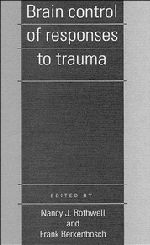Book contents
- Frontmatter
- Contents
- Contributors
- 1 Introduction
- 2 Responses to injury
- 3 Experimental approaches to the central nervous system control of responses to trauma
- 4 Neurohormonal control of cytokines during injury
- 5 Brain regions involved in modulation of immune responses
- 6 Psychological and neurobiological consequences of trauma
- 7 Central nervous system control of sickness behavior
- 8 Psychological and behavioural aspects of pain
- 9 Central control of cardiovascular responses to injury
- 10 Neuroendocrine responses to physical trauma
- 11 Central control of metabolic and thermoregulatory responses to injury
- 12 Central control of pain
- 13 The final word …
- Index
8 - Psychological and behavioural aspects of pain
Published online by Cambridge University Press: 05 August 2016
- Frontmatter
- Contents
- Contributors
- 1 Introduction
- 2 Responses to injury
- 3 Experimental approaches to the central nervous system control of responses to trauma
- 4 Neurohormonal control of cytokines during injury
- 5 Brain regions involved in modulation of immune responses
- 6 Psychological and neurobiological consequences of trauma
- 7 Central nervous system control of sickness behavior
- 8 Psychological and behavioural aspects of pain
- 9 Central control of cardiovascular responses to injury
- 10 Neuroendocrine responses to physical trauma
- 11 Central control of metabolic and thermoregulatory responses to injury
- 12 Central control of pain
- 13 The final word …
- Index
Summary
Pain
Introduction
The pathophysiological and biochemical changes in the tissue produced by trauma are detected by two systems, nervous and immune. Detection by nervous system leads to behavioural responses that may alleviate the pain and favour recovery. This includes inactivity and immobilization. The withdrawal and immobilization are often efficient behavioural precautions against predators and against further traumatization.
Detection by the immune system leads to a cascade of immunological events that also favour healing. These responses are not limited to the identification and destruction of antigens and foreign material ('non-self’). The signal substances, in particular interleukin-1 (IL-1), also affect behaviour. It is very interesting that the behaviour effect is seen as the same withdrawal or inactivity resulting from the pain itself. If the trauma leads to infection and fever, the fever itself also leads to inactivity, possibly via the IL-1 mechanism. Finally, recent data point to the interaction between these systems. The signal substances are similar or the same in the periphery and in the brain. These systems are not as stimulus-bound or ‘reflexive’ as believed originally. Both pain transmission and immune responses are influenced by the central nervous system (CNS), and, therefore, also by psychological factors. Traumas do not seem to hit us totally at random, and the responses to trauma are also clearly influenced by psychological factors (Malt et a/., 1987; Malt, 1992).
The psychological and behavioural aspects of pain are important from a general scientific point of view, since they involve basic survival mechanisms. The field is also important, since it may reveal basic mechanisms that affect therapy and prognosis for pain patients. A particularly important aspect is the possible consequences for therapy and prognosis of the increasing number of chronic pain patients.
Pain
The concept of pain is used to cover a rich variety of human and animal suffering. The International Association for the Study of Pain, chaired by Merskey (1979), defined pain as ‘an unpleasant sensory and emotional experience associated with actual or potential tissue damage, or described in terms of such damage’. They added crucial notes to this definition pointing to the fact that it avoids tying pain to the stimulus, and that activity induced in nociceptors and nociceptive pathways by noxious stimuli is not pain, which is always a psychological state (Merksey, 1979).
- Type
- Chapter
- Information
- Brain Control of Responses to Trauma , pp. 183 - 201Publisher: Cambridge University PressPrint publication year: 1994
- 1
- Cited by



